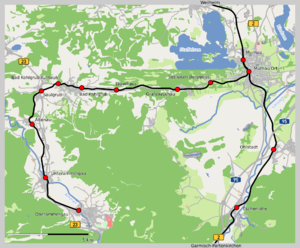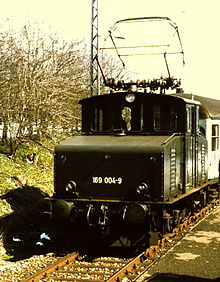Murnau – Oberammergau railway line
| Murnau – Oberammergau | |||||||||||||||||||||||||||||||||||||||||||||||||||||||||||||||||||||||||
|---|---|---|---|---|---|---|---|---|---|---|---|---|---|---|---|---|---|---|---|---|---|---|---|---|---|---|---|---|---|---|---|---|---|---|---|---|---|---|---|---|---|---|---|---|---|---|---|---|---|---|---|---|---|---|---|---|---|---|---|---|---|---|---|---|---|---|---|---|---|---|---|---|---|
|
In 2007 the former
Oberammergau station was only a stopping point | |||||||||||||||||||||||||||||||||||||||||||||||||||||||||||||||||||||||||
| Route number (DB) : | 5451 | ||||||||||||||||||||||||||||||||||||||||||||||||||||||||||||||||||||||||
| Course book section (DB) : | 963 | ||||||||||||||||||||||||||||||||||||||||||||||||||||||||||||||||||||||||
| Route length: | 23.671 km | ||||||||||||||||||||||||||||||||||||||||||||||||||||||||||||||||||||||||
| Gauge : | 1435 mm ( standard gauge ) | ||||||||||||||||||||||||||||||||||||||||||||||||||||||||||||||||||||||||
| Route class : | B2 | ||||||||||||||||||||||||||||||||||||||||||||||||||||||||||||||||||||||||
| Power system : | 5.5 kV 16 Hz 5 kV 16 ⅔ Hz until 1954 15 kV 16 ⅔ Hz ~ |
||||||||||||||||||||||||||||||||||||||||||||||||||||||||||||||||||||||||
| Top speed: | 60 km / h | ||||||||||||||||||||||||||||||||||||||||||||||||||||||||||||||||||||||||
|
|||||||||||||||||||||||||||||||||||||||||||||||||||||||||||||||||||||||||
The Murnau – Oberammergau railway , also known as the Ammergaubahn or Ammertalbahn - until 1938: the Murnau – Oberammergau local railway - is an electrified branch line in Bavaria . It branches off the main line Munich – Garmisch-Partenkirchen in Murnau and leads to Oberammergau . In the second half of the route, it follows the valley of the Ammer .
The line is considered the first electrified full- line railway in Germany.
history

On January 24, 1897, the Actiengesellschaft Elektrizitätswerke, formerly OL Kummer & Co., Dresden, Munich, received the concession from the Bavarian Prince Regent Luitpold to build an electrically operated single-track railway line from Murnau to Oberammergau. In the following years up to 1900 the line was built together with the Kammerl hydroelectric power station , so that on January 13, 1900 the first test train could drive the line. A few months later on April 5, 1900, the opening of the line was finally approved. However, this permit only included the operation of the railway line, not electrical operation. The planned train operation with three-phase alternating current with 800 volts and 40 Hz failed because of the electrotechnical problems that were not yet mastered at the time and never got beyond test drives. Instead, eleven steam locomotives of the class D XI with the C1'n2t wheel arrangement supplied by Krauss München were used on the newly built tracks for the Oberammergau Passion Play in 1900 from April 5 .
After the bankruptcy of the operator, the Lokalbahn Aktien-Gesellschaft acquired the railway line and the power station in November 1903, which it had converted from March to November 1904 with 280 kW 350 kVA traction current generators for the production of single-phase alternating current with 5500 volts and 16 Hz received the operating license on December 31, 1903. On January 1, 1905, the electrical planned operation with the railcars LAG No. 674 to 677 began. The company was fed by the Kammerl hydropower plant, which was built in 1899 and converted from 1904 to 1905. This made the Ammergaubahn the first railway in Germany to be operated with single-phase, low-frequency alternating current , the current system still used in Central and Northern Europe today. Earlier railways used direct current, three-phase current or (like the Stubaitalbahn, which opened a few months earlier ), high-frequency alternating current.
On June 2, 1921, a freight train in the direction of Murnau and a passenger train in the opposite direction collided head-on between Bad Kohlgrub and Grafenaschau. The accident resulted in three seriously injured and around 8 slightly injured. There was also major material damage to the E69 series locomotives affected and to the wagons.
With effect from August 1, 1938, the LAG was transferred to the Deutsche Reichsbahn . While the Reichsbahn had long been running at 15,000 volts 16 2/3 Hz, the island operation of the Ammergaubahn, which was supplied by the Kammerl power plant with 5500 volts 16 Hz, was retained until the renovations in 1951 to 1953, when the railway and the power plant were on traction current generally used and a single-phase transformer and switchgear installed in the power station for each of the three generators.
With the increase in individual traffic, the number of passengers on the Ammergaubahn fell to between 500 and 1000 passengers a day. At the same time, freight traffic also almost completely disappeared. Therefore there was a massive dismantling of the infrastructure.
In 1999 there were negotiations with the Pro Bahn passenger association and DB Regio Bayern AG. Pro Bahn demanded, among other things, the preservation of the crossing possibility in Altenau (Bay) and the preservation of the second track in Oberammergau. This could have shortened the travel time by around ten minutes. But the cost of around four million Deutschmarks was too high and the project was put on hold.
The route has recently been extensively modernized. However, this modernization also fell victim to all of the infrastructure that was no longer required in the planned operation , which brought Deutsche Bahn massive criticism from the Pro Bahn passenger association, among other things. At the Oberammergau terminus, for example, there has only been one track since the renovation in autumn 2005, the remaining area was built over with a bus station , among other things . In this context, the terminus was downgraded from a train station to a stopping point . The Grafenaschau and Unterammergau stations have also been downgraded to simple stops, and trains have not met there since then. As a result of these rationalization measures, special trips are no longer possible on the route to Oberammergau during the day because there are no longer any intersections available. The only remaining possibility of crossing in Bad Kohlgrub is required for the planned operation, there the trains cross every hour. Furthermore, it is no longer possible to move at the Oberammergau terminus; only push-pull trains or multiple units can be used there.
In the Bad Kohlgrub area, ten kilometers of the approximately 80-year-old tracks were renewed, the new rails were endlessly welded. In addition, the line was equipped with the digital train radio system GSM-R in 2005 . Since November 28, 2008, the line has been remote-controlled from the Garmisch-Partenkirchen electronic interlocking . This measure also means that the dispatcher previously used in Bad Kohlgrub can be saved.
The Seeleiten-Berggeist, Jägerhaus and Bad Kohlgrub Kurhaus stops are or were operated as demand stops . In Jägerhaus, the trains drove through in the dark for safety reasons because there is no platform lighting there. The stop in Jägerhaus was completely abandoned when the timetable changed on December 11, 2016. Equipment with lighting and passenger information, which is required by law, is considered to be too expensive in view of the small number of passengers of less than ten people a day.
Electrical system
While the change in the power system in 1951/1953 or 1954/1955 to 15,000 volts / 16 ⅔ Hz is undisputed, there are different statements about the first electric power system and the first system change of the local railway at that time:
- 5500 volts at 15 Hz then later system change to 5000 volts and increase of the frequency to 16 ⅔ Hz
- 5000 volts at 16 Hz and increase in 1954 to 16 ⅔ Hz
- 5500 volts at 16 Hz
- 5500 volts at 16 ⅔ Hz
If the first unsuccessful attempt with 800 V 40 Hz is ignored, according to Ralf Specht the Ammergaubahn ran continuously and unchanged at 5500 V and 16 Hz from 1905 until the end of island operation in 1951/1955.
When switching to 15,000 volts and 16 ⅔ Hz, four of the five electric locomotives of the E 69 series were converted accordingly.
Vehicle use
After the origin locomotives of the 169 series were retired in the early 1980s because of an aging population, it was replaced by electric locomotives of class 141 . This did not change anything on the rolling stock used, n-type cars were still used (two passenger cars per train ). A few years ago, the locomotive-hauled trains were finally replaced by modern class 425 or 426 railcars, and two rounds were required for scheduled operation. The last push-pull trains with the 141 series ran in autumn 2004. Since the summer of 2013, instead of the 425 and 426 vehicles, electric multiple units of the type Bombardier Talent 2 (442 series) have been running in advance of the Werdenfelsbahn. Two rounds are still required in planned operation.
literature
- Ralf Roman Rossberg : The Murnau – Oberammergau Local Railway. Frankh'sche Verlagshandlung, Stuttgart 1970, ISBN 3-440-03731-2 .
- Ralf Roman Rossberg: The Murnau – Oberammergau Local Railway. In: Railway courier. No. 215 / year 24/1990. EK-Verlag, ISSN 0170-5288 , pp. 46-48.
- Bernd Mühlstraßer: The E 69 series: The Bavarian local electric locomotives and the Murnau – Oberammergau line. EK-Verlag, Freiburg 2005, ISBN 3-88255-169-0 .
- Peter Blath: The local railway Murnau - Oberammergau. In: Rail traffic in Werdenfelser Land. Sutton-Verlag, Erfurt 2005, ISBN 3-89702-886-7 .
- Hermann Bürnheim: Localbahn A.-G. Munich 13th local railway Murnau-Oberammergau. Zeunert, Gifhorn 1974, ISBN 3-921237-21-1 , pp. 76-78.
Web links
- Information about the route at www.mittenwaldbahn.de
- Course book table from 1944
- Course book and train formation 1958
- Station database of the Bavarian Railway Company with information for passengers (accessed on November 24, 2013): Murnau , Murnau Ort , Seeleiten-Berggeist , Grafenaschau , Jägerhaus , Bad Kohlgrub , Bad Kohlgrub Kurhaus , Saulgrub , Altenau , Unterammergau , Oberammergau
Individual evidence
- ↑ a b Freilassing depot. (PDF; 11.4 MB) In: flr.luciaclemens.de. Archived from the original on May 22, 2014 ; accessed on February 23, 2013 .
- ^ Ralf Specht: History and technology of the hydroelectric power station Kammerl. In: Electric Railways. 99 (2001), 11, pp. 444-452.
- ^ Peter Blath: Rail traffic in the Werdenfelser Land . Sutton Verlag, Erfurt 2005, ISBN 3-89702-886-7 , p. 51 .
- ^ Ralf Roman Rossberg: "Railway power" as an ingenious stopgap solution. In: schule.de. 2005, archived from the original on February 18, 2013 ; accessed on February 23, 2013 .
- ↑ Hermann Bürnheim: Localbahn A.-G. Munich 13th local railway Murnau-Oberammergau. Zeunert, Gifhorn, ISBN 3-921237-21-1 , p. 72.
- ↑ 1903 according to Ralf Specht, November 19th , 1900 according to the bronze plaque at the entrance of the power plant
- ↑ inaccurate, probably: Deutsche Reichsbahn: Handbook of German Railway Lines; Opening dates 1835–1935 . Berlin 1935; Reprint Dumjahn, Mainz 1984, ISBN 3-921426-29-4 No. 1900/12
- ^ Peter Blath: Rail traffic in the Werdenfelser Land . Sutton Verlag, Erfurt 2005, ISBN 3-89702-886-7 , p. 62-63 .
- ↑ Ammergaubahn. Pro Bahn Werdenfels, accessed on November 16, 2013 .
- ↑ so Ralf Specht
- ↑ so probably the following sources
- ^ History of the first state railway in Bavaria, "Electrification". In: kbs820.jimdo.com. Retrieved February 23, 2013 .
- ↑ Eisenbahnen-der-Welt, development of the electric railway operation. In: eisenbahnen-der-welt.de. Retrieved February 23, 2013 .
- ↑ Design differences - series 169. In: bundesbahnzeit.de. Retrieved February 23, 2013 .
- ↑ Murnau-Oberammergau. In: bundesbahnzeit.de. Retrieved February 23, 2013 .
- ↑ KBS 963 - The Ammergaubahn. In: Mittewaldbahn.de. Archived from the original on July 19, 2011 ; accessed on February 23, 2013 .
- ^ VDI news from January 7, 2005. In: schule.de. Archived from the original on February 18, 2013 ; accessed on February 23, 2013 .
- ^ Vehicle hall on the website of the DB Museum in Nuremberg. In: deutschebahn.com. Retrieved February 23, 2013 .
- ↑ Georg Schwach: Overhead lines for alternating current in Germany, Bern 1989, p. 472. (Electrification data with the note “Clearly documented by RR Rossberg, Die Lokalbahn Murnau - Oberammergau, Stuttgart 1970”). (PDF; 1.5 MB) In: homepage.hispeed.ch. Archived from the original on January 11, 2015 ; accessed on February 23, 2013 .
- ↑ Historical development of electric train transport. In: tu-dresden.de. TU Dresden, archived from the original on August 6, 2013 ; accessed on February 23, 2013 .


